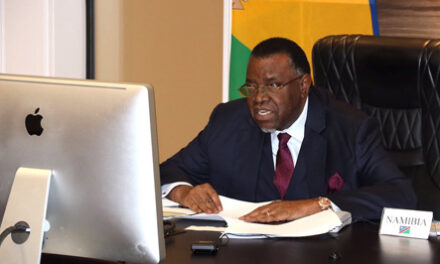
Namibia opens up trade with Mercosur countries

By Maria Lisa Immanuel
Senior Trade and Investment Analyst
Namibia Trade Forum
Namibia opens up trade with Mercosur countries as the SACU – MERCOSUR Preferential Trade Agreement enters into force.
Namibia can now trade with Mercosur countries (Argentina, Brazil, Uruguay, Paraguay) on a preferential basis under the SACU – Mercosur Preferential Trade Agreement (PTA) which entered into force on 1 April. This is the second concluded international trade agreement by SACU countries (Botswana, Lesotho, Namibia, South Africa and Swaziland), the first one being the SACU-EFTA Free Trade Agreement (FTA) which was implemented in 2008.
This SACU – Mercosur PTA was concluded 11 years ago but was never implemented until recently due to ratification processes which are purely depended on the national laws of individual countries. Indeed trade agreements such as this one should be embraced from a point of government effort to create alternative market access for the private sector to trade and also to participate in global value chains, especially for a small market like Namibia.
On the other hand, what really matters is how the private sector embrace this agreement as they are the ones to implement it. Thus, this analysis aims to highlight some of the key products of interest to Namibia in terms of import and export as well as to give a private sector or industries perspective on how the agreement impacts their respective industries and ultimately how it will influence their business models.
First and foremost, it should be made clear that a preferential trade agreement such as this one is based on the premise that the two markets of SACU and Mercosur will trade certain products on preferential terms based on reduced tariff rates. Article 2 of Chapter 1 of this PTA which covers the purpose of the agreement states that the countries agree to establish fixed preference margins as a first step towards the creation of a free trade area. Other important trade instruments covered in the agreement are Rules of Origin, Technical Barriers to Trade (TBT), Sanitary and Phytosanitary Measures (SPS) and Dispute Settlement Mechanisms (DSU) to deal with disputes arising in connection with the application, interpretation and non-compliance of the agreement.
Some of the key products of interest to Namibia contained in this Agreement is Boneless beef.
The agreement grants two Mercosur countries, Paraguay and Uruguay a total of 500 tonnes of boneless beef (250 tons each) to be imported into the SACU market. This boneless beef classified under HS 0202 30 00 will be subject to a Margin of Preference (MP) tariff rate quota of 25%. For the sake of reciprocity, Namibia is allowed to export carcasses and half carcasses at a MP tariff rate of 25%.
According to the Meat Board of Namibia, the agreement might be viewed more as a threat than an opportunity for the beef sector at the moment as Mercosur countries are more cost effective when it comes to beef production. By implication, beef imported into Namibia is able to land cheaply and hence have a direct influence on the Namibian producer price. The other critical threat for Namibia relates to SPS measures. The beef sector cautioned that there has been regular outbreak of FMD in the past especially in Paraguay which led the EU banning Brazilian imports from 3 Brazilian states bordering Paraguay. Namibia is a net exporter of beef having access to lucrative niche markets in the EU and Norway and therefore strict control mechanisms and verification systems are important to monitor beef imports from Mercosur under this agreement to avoid jeopardising access to existing markets.
Fish products are equally key to Namibia’s economy and hence the analysis highlights some of the fish products covered in the agreement. The agreement allows importation of Anchovies, herrings, flours, meals and fish pellets fit for human consumption, frozen rock lobsters, Shrimps and Prawn frozen, Crabs frozen into the SACU market.
All these products will attract a MP tariff rate of 100%, i.e. zero tariff. For Namibia to export fish products such as Horse Mackerel and Hake to Mercosur market, it will attract a MP tariff rate of 25% when exporting to Brazil and Paraguay and Sardines will attract a tariff rate of 100% when exported to Argentine, Brazil and Uruguay while to Paraguay it’s only 25% tariff rate.
The fishing sector argues that it does not see large developments in terms of exports especially for hake because countries like Argentine and Uruguay have fishing industries which compete with Namibian hake on the world market. Consequently, they are able to supply hake to their domestic market and also to their neighbour Brazil leaving less room for demand of Namibian hake. In addition, the tariff rate is too high for Namibia making this a less attractive export market for Namibia especially when the EU market offers duty free quota free market access of fish products from Namibia under the Economic Partnership Agreement (EPA). However, Namibia can look at the feasibility of importing prawns since Namibia does not produce prawns.
Namibia can import from Mercosur products such as Cabbage lettuce, Carrots, banana (fresh or dried), and Avocados at a MP tariff rate of 100%. Durum wheat, used mainly by the milling industry as inputs into ‘certain’ pasta can be imported at 50% MP tariff rate from Paraguay only. Both Paraguay and Uruguay are granted Soy beans quotas to export into the SACU market. Paraguay is given 10 000 tons and Uruguay 6000 tons annually at a MP tariff rate quota of 25%. Again, Paraguay is allowed to export 5000 and 4000 tons of Soy bean oils and Sunflower oil respectively at a MP tariff rate quota of 25%. Wheat and maize are also covered in the agreement and imports into SACU are subject to a MP tariff rate of 25%.
Namibia being the second largest producer of sea salt in Africa after Egypt has a comparative advantage in salt production. Due to its superior quality, Namibian salt is sought after in international markets such as the EU where approximately 50,000 tons of salt is exported annually to Belgium. Brazil could also be a potential market for Namibian salt. For Namibia to export salt to Mercosur, it will be subject to a MP tariff rate of 100% for sea salt and 50% for table salt. This is quite interesting because the table salt which is the value added product becomes a bit restrictive to export as opposed to the sea salt (used as raw material in many chemical industries) which can be exported at almost zero tariff.
To conclude, the analysis looked at the 5 year trade flow between Namibia and Mercosur countries obtained from the Namibia Statistics Agency (NSA).
In 2012 and 2013 Namibia exported beef to Brazil at the value N$2.7 million while beef and beef products imported into Namibia from Brazil in 2014 and 2015 was valued at N$1.3 million. A significant trade recorded in value was the importation of Poultry products predominantly from Argentina valued at N$118 million over a 5 year period (2011 to 2015). This means annually, Namibia is importing chicken valued at N$23 million from Argentina. Over the past 5 years, Namibia also imported chicken and chicken products from Uruguay valued at N$27 million.
Other products imported by Namibia mainly from Brazil is rice and sugar valued at N$47 million and N$51 million in the past 5 years respectively.
Namibia has also been exporting some hides and skins as well as tanned skins to Argentine valued at about N$900 000 in the past 5 years.
Other significant imports from Mercosur are mainly agricultural implements such as tractors, agricultural machinery, etc. They are mainly imported from Brazil and Argentina.
Namibia should prioritise the implementation of this agreement by sensitising the private sector and creating awareness of opportunities created by this agreement. The Mercosur countries are quite advanced in industrialisation and Namibia should adopt a clear strategy on how to promote this trade agreement especially in relations to industrialisation.












































